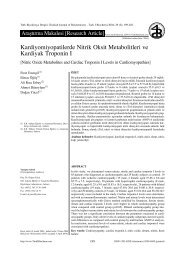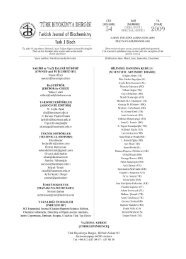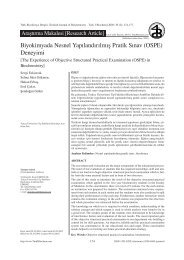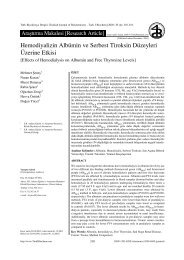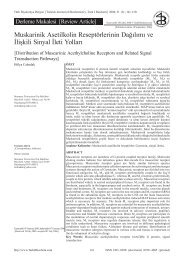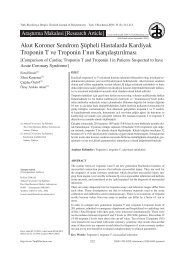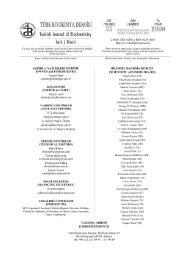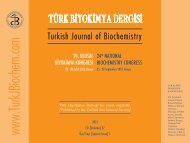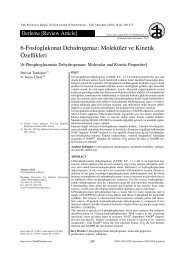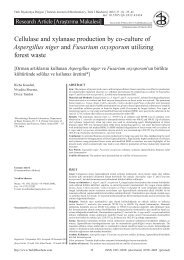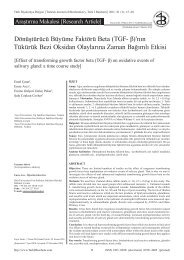Enhanced Production of Citric Acid by Aspergillus niger M-101 ...
Enhanced Production of Citric Acid by Aspergillus niger M-101 ...
Enhanced Production of Citric Acid by Aspergillus niger M-101 ...
- No tags were found...
Create successful ePaper yourself
Turn your PDF publications into a flip-book with our unique Google optimized e-Paper software.
Türk Biyokimya Dergisi [Turkish Journal <strong>of</strong> Biochemistry–Turk J Biochem] 2010; 35 (1) ; 7–13.<br />
Research Article [Araştırma Makalesi]<br />
Yayın tarihi 20 Mart, 2010 © TurkJBiochem.com<br />
[Published online 20 March, 2010]<br />
<strong>Enhanced</strong> <strong>Production</strong> <strong>of</strong> <strong>Citric</strong> <strong>Acid</strong> <strong>by</strong> <strong>Aspergillus</strong> <strong>niger</strong><br />
M-<strong>101</strong> Using Lower Alcohols<br />
[<strong>Aspergillus</strong> <strong>niger</strong> M-<strong>101</strong> Tarafından Üretilen Sitrik Asit Miktarı Düşük Molekül<br />
Ağırlıklı Alkoller Kullanıldığında Artmaktadır]<br />
1<br />
Aftab Nadeem,<br />
2<br />
Quratulain Syed,<br />
2<br />
Shahjahan Baig,<br />
2<br />
Muhammad Irfan and<br />
2<br />
Muhammad Nadeem<br />
1<br />
Department <strong>of</strong> Pathology, Shaukat Khanum<br />
Memorial Cancer Hospital & Research Centre,<br />
Lahore-13014, Pakistan<br />
2<br />
Food and Biotechnology Research Centre, PCSIR<br />
Labs. Complex, Lahore-54600, Pakistan<br />
Yazışma Adresi<br />
[Correspondence Address]<br />
Dr. Quratulain Syed<br />
Principal Scientific Officer,<br />
Biotechnology and Food Research Centre,<br />
PCSIR Labs. Complex, Lahore-54600, Pakistan<br />
Tel: 0092429231834<br />
Fax: 0092429231835<br />
Email: quratulainasad@yahoo.com<br />
Registered: 25 May 2009; Accepted: 3 October 2009<br />
[Kayıt tarihi : 25 mayıs 2009 ; Kabul tarihi : 3 Ekim 2009]<br />
ABSTRACT<br />
Objective: <strong>Citric</strong> acid is mainly produced <strong>by</strong> submerged fermentation <strong>of</strong> <strong>Aspergillus</strong><br />
<strong>niger</strong>. The process yield depends on the composition <strong>of</strong> the medium, as well as<br />
on the microorganism strain.<br />
Materials and Methods: In the present study citric acid production <strong>by</strong> <strong>Aspergillus</strong><br />
<strong>niger</strong> M-<strong>101</strong> using lower alcohols such as methanol and ethanol at concentration <strong>of</strong><br />
0.5 to 2.0 % (v/v) was optimized in shake flask culture using beet molasses as fermentation<br />
medium.<br />
Results: Methanol (1.5 %) and ethanol (1 %) was found optimal for maximum citric<br />
acid production (49.33±4.23 g/l) and (40.85±0.48 g/l) respectively. The effect <strong>of</strong><br />
addition <strong>of</strong> ethanol and methanol to the fermentation medium at different time intervals<br />
on citric acid production demonstrate that maximum citric (44.62±2.12 g/l)<br />
and (55.13±1.53 g/l) was produced after 30 h and 45 h <strong>of</strong> incubation period. The yield<br />
for methanol and ethanol was 1.54 and 2.33 higher than the control experiment.<br />
Conclusion: From the present study it is concluded that both methanol and ethanol<br />
under optimized conditions increases the permeability <strong>of</strong> cell membrane <strong>of</strong> <strong>Aspergillus</strong><br />
<strong>niger</strong> M-<strong>101</strong> that result in accumulation <strong>of</strong> citric acid in fermentation medium.<br />
The kinetic assessments demonstrate that there was a significant enhancement<br />
(p ≤ 0.05) in citric acid production over the control fermentation medium. The<br />
best results for the production <strong>of</strong> citric acid were observed after 192 h <strong>of</strong> fermentation<br />
period.<br />
Key Words: <strong>Aspergillus</strong> <strong>niger</strong>, methanol, ethanol, citric acid, kinetic assessments<br />
ÖZET<br />
Amaç: Sitrik asit Asregillus <strong>niger</strong> tarafından batık kültür fermentasyonu ile üretilmektedir.<br />
Bu üretimin verimi mikroorganizmanın suşuna bağlı olduğu kadar besi<br />
ortamının bileşiminden de etkilenmedir.<br />
Methods: Çalışmada <strong>Aspergillus</strong> <strong>niger</strong> M-<strong>101</strong> tarafından sitrik asit üretimi, % 0.5-<br />
2 derişimde methanol ve etanol gibi düşük molekül ağırlıklı alkollerin varlığında<br />
sallamalı kültür ortamında optimize edildi. Fermentasyon ortamı olarak pancar<br />
melası kullanıldı.<br />
Bulgular: Metanol (% 1.5) ve etanol (% 1) fazla miktarda sitrik asit üretimi için (sırasıyla<br />
49.33±4.23 g/l ve 40.85±0.48 g/l) uygun olarak saptandı. Farklı zaman aralıklarında<br />
fermentasyon ortamına alkol eklenmesinin sitrik asit üretimine olan etkisine<br />
bakıldığında; etanol için 30 saat, methanol için ise 45 saat inkübasyon süresinden<br />
sonra en fazla üretimin (sırasıyla 44.62±2.12 g/l ve 55.13±1.53 g/l) gerçekleştiği<br />
bulundu. Kontrol grubuna göre kıyaslandığında methanol ve etanol eklendiğindeki<br />
verim 1.54 ve 2.33 olarak hesaplandı.<br />
Tartışma: Optimize edilmiş koşullar altında methanol ve etanol <strong>Aspergillus</strong> <strong>niger</strong><br />
M-<strong>101</strong>’in hücre membranı geçirgenliğini arttırmakta ve sitrik asit fermentasyon<br />
ortamında birikmektedir. Kinetik çalışmalar kontrol grubuna kıyasla sitrik asit<br />
üretiminde belirgin bir artış oluğunu (p ≤ 0.05) göstermektedir. Sitrik asit üretimi<br />
için en iyi sonuçlar 192 saatlik fermentasyon döneminden sonra elde edilmektedir.<br />
Anahtar Kelimeler: <strong>Aspergillus</strong> <strong>niger</strong>, metanol, etanol, sitrik asit, kinetik değerlendirme<br />
http://www.TurkJBiochem.com<br />
7<br />
ISSN 1303–829X (electronic) 0250–4685 (printed)
Introduction<br />
<strong>Citric</strong> acid (2-hydroxy-propane-1,2,3-tricarboxylic acid)<br />
is a tricarboxylic acid with a molecular weight <strong>of</strong> 210.14<br />
Da. In view <strong>of</strong> its three carboxylic acid functional groups,<br />
it has three pKa values at pH 3.1, 4.7, and 6.4. <strong>Citric</strong> acid<br />
is a nearly universal intermediate product <strong>of</strong> metabolism<br />
and its traces are found in virtually all plants and animals<br />
(1). It is solid at room temperature, melts at 153 °C<br />
and decomposes at higher temperature (2).<br />
Among the organic acids industrially produced, citric<br />
acid is the most important in quantitative terms with an<br />
estimated annual production <strong>of</strong> about 1.4 million tons<br />
(3). The annual growth <strong>of</strong> its demand/consumption rate<br />
is around 3.5-4.0 % (4). The food industry consumes<br />
about 70 % <strong>of</strong> total citric acid produced and pharmaceutical<br />
industries consume about 12 %, and the remaining<br />
18 % are consumed <strong>by</strong> other industries (4-5). <strong>Citric</strong> acid<br />
is used in the food, beverage, pharmaceutical, chemical,<br />
cosmetic and other industries for applications such as<br />
acidulation, antioxidation, flavour enhancement, preservation,<br />
plasticizer and as a synergistic agent (6). <strong>Citric</strong><br />
acid is used to flavour the drinks, jams and jellies, candies,<br />
water ice and wines (7).<br />
<strong>Citric</strong> acid production can be done <strong>by</strong> solid-state fermentation<br />
or with submerged fermentation (8). To date, most<br />
industrial processes are carried out with submerged<br />
fermentation <strong>of</strong> <strong>Aspergillus</strong> <strong>niger</strong>. The process yield<br />
depends on the composition <strong>of</strong> the medium, as well as<br />
on the microorganism strain (9). <strong>Aspergillus</strong> <strong>niger</strong> has<br />
been used commercially for the first time in 1923 for<br />
citric acid production and it remained the organism <strong>of</strong><br />
choice for commercial production because it produces<br />
more citric acid per time unit. Recently a wide range <strong>of</strong><br />
citric acid production has been reported in response to<br />
different levels <strong>of</strong> nutrient supplementation (10-13).The<br />
problem in the production <strong>of</strong> citric acid for yeasts is the<br />
simultaneous formation <strong>of</strong> isocitrate. The main advantages<br />
<strong>of</strong> using <strong>Aspergillus</strong> <strong>niger</strong> are its ease <strong>of</strong> handling,<br />
its ability to ferment a variety <strong>of</strong> cheap raw materials<br />
and high yields (3,14). The yield <strong>of</strong> citric acid from these<br />
strains <strong>of</strong>ten exceeds 70 % <strong>of</strong> the theoretical yield on<br />
the carbon source (1). The production <strong>of</strong> citric acid using<br />
cheap carbon source from agro-industrial <strong>by</strong>products<br />
provides considerable combined benefit <strong>of</strong> waste material<br />
management as well as decrease <strong>of</strong> citric acid production<br />
cost (15-16).<br />
The use <strong>of</strong> alcohols as a stimulant in citric acid production<br />
may enhance the yield <strong>of</strong> citric acid (17). The<br />
stimulatory effect <strong>of</strong> ethanol and methanol on citric acid<br />
production can be explained in terms <strong>of</strong> mycelia morphology<br />
as well as pellet shape and size (18). <strong>Citric</strong> acid<br />
production could be increased <strong>by</strong> exploiting available<br />
resources and adding the stimulatory agents to the fermentation<br />
medium (19). The main purpose <strong>of</strong> the present<br />
study was to investigate the stimulatory effect <strong>of</strong> lower<br />
alcohols on citric acid production and its optimization.<br />
Turk J Biochem, 2010; 35 (1) ; 7–13.<br />
8<br />
Materials and Methods<br />
Microorganism<br />
<strong>Aspergillus</strong> <strong>niger</strong> M-<strong>101</strong> was obtained from Pakistan<br />
Type Culture collection at Food Biotechnology Research<br />
Centre PCSIR Laboratories, Lahore, Pakistan. It was<br />
maintained on Potato dextrose agar (PDA) slants and<br />
stored at 4 ºC in a refrigerator. The culture was renewed<br />
after every month throughout the investigation period.<br />
Composition <strong>of</strong> beet molasses<br />
Approximate analysis <strong>of</strong> beet molasses was done according<br />
to the method <strong>of</strong> Ranganna (20). Molasses<br />
(obtained from Premier Sugar Mills, Mardan, NWFP,<br />
Pakistan) used in the experimental work was initially<br />
homogenized. Suitable dilution <strong>of</strong> molasses was done as<br />
required <strong>by</strong> the experiments. Composition <strong>of</strong> molasses<br />
used in this study is given in Table 1.<br />
Table 1. Proximate analysis <strong>of</strong> beet molasses<br />
Constituent Dry weight basis (%)<br />
Moisture 19.4<br />
Dry Solids 81.6<br />
Ash 8.5<br />
Total Reducing Sugar 17.21<br />
Total Sugar 60.19<br />
Sucrose (non reducing sugar) 42.98<br />
Nitrogen 0.38<br />
Clarification <strong>of</strong> beet molasses<br />
Clarification <strong>of</strong> beet molasses using sulfuric acid treatment<br />
was done according to the method <strong>of</strong> Mayilvahanan<br />
et al. (21). The pH <strong>of</strong> the molasses (25 % total sugar)<br />
was adjusted to 3.0 <strong>by</strong> adding 0.1 N sulphuric acid. This<br />
was allowed to stand for 1.5 hours and then centrifuged<br />
at 3000 rpm for 15 minutes. Clarified beet molasses was<br />
diluted with distilled water to obtain 150 g/l sugar concentration.<br />
The supernatant was collected and used for<br />
citric acid production.<br />
Basal fermentation media<br />
The following fermentation media (g/l) was employed for<br />
citric acid production according to the modified method<br />
<strong>of</strong> Lotfy et al. (22): Beet molasses, 150.0; NaNO 3<br />
, 4.0;<br />
KH 2<br />
PO 4<br />
, 1.0; MgSO 4<br />
7H 2<br />
O, 0.23; FeCl 3<br />
, 0.02; ZnSO 4<br />
,<br />
0.0012; MnCl 2·H 2<br />
O, 0.0012 (pH 4±0.2).<br />
Inoculum<br />
The spore suspensions <strong>of</strong> fungal strains were prepared<br />
<strong>by</strong> washing 5-7 days old culture slants with sterilized<br />
saline solution (0.9 % NaCl) with shaking vigorously for<br />
1min. Spores were counted <strong>by</strong> a haemocytometer to adjust<br />
the count to approximately 10 8 spores/ml.<br />
Nadeem et al.
Fermentation<br />
The spores <strong>of</strong> <strong>Aspergillus</strong> <strong>niger</strong> M-<strong>101</strong> was allowed to<br />
grow in 50 ml aliquots <strong>of</strong> the fermentation medium dispensed<br />
in 250 ml Erlenmeyer flasks. Each flask was inoculated<br />
with 1 % (v/v) inoculum containing 10 8 spores/<br />
ml. Cultures were then incubated at 30±2 °C under<br />
shaking M-<strong>101</strong>. conditions at 200 rpm for 192 h. The flow sheet<br />
<strong>of</strong> fermentation process is given in figure 1.<br />
Figure 1. Flow sheet <strong>of</strong> fermentation process for the production <strong>of</strong> citric acid <strong>by</strong> <strong>Aspergillus</strong> <strong>niger</strong><br />
Clarification <strong>of</strong><br />
beet molasses<br />
Figure 1. Flow sheet <strong>of</strong> fermentation process for the production <strong>of</strong><br />
citric acid <strong>by</strong> <strong>Aspergillus</strong> <strong>niger</strong> M-<strong>101</strong>.<br />
Analytical methods<br />
Stock Culture<br />
(<strong>Aspergillus</strong> <strong>niger</strong> M-<strong>101</strong>)<br />
Subculture on PDA slants at<br />
30±2 o C for 7 days<br />
Inoculum Development<br />
(Spore suspension in 0.9 % NaCl)<br />
The fermentation broth was filtered through filter paper<br />
in order to remove mycelia. The filtrate was then used<br />
for further analysis. Biomass was determined according<br />
to the method reported <strong>by</strong> Kiramura et al. (23). <strong>Citric</strong><br />
acid in filtrate was estimated spectrophotometrically,<br />
using pyridine–acetic anhydride method as given <strong>by</strong><br />
Marrier and Boulet (24). Reducing sugar was estimated<br />
<strong>by</strong> 3,5-dinitrosalicyclic acid (DNS) method (25).<br />
Kinetic parameters and statistical analysis<br />
Kinetic parameters for batch fermentation were determined<br />
after Pirt (26). Statistical analysis was done <strong>by</strong><br />
ANOVA test using Minitab (version 15) s<strong>of</strong>tware. The<br />
difference in values was indicated in the form <strong>of</strong> probability<br />
(p ≤ 0.05) values.<br />
Results and Discussion<br />
Fermentation in 250 ml shake flask<br />
contains 50 ml fermentation media,<br />
incubated at 30±2 o C for 192 hrs at<br />
200 rpm.<br />
Filtration<br />
Residue<br />
(Cell biomass)<br />
Addition <strong>of</strong><br />
ethanol/methanol<br />
Supernatant for citric<br />
acid estimation<br />
were 17.23 and 60.16 % respectively. While the amount<br />
<strong>of</strong> nitrogen present in beet molasses was 0.38 %. The<br />
reported values <strong>of</strong> molasses were also given <strong>by</strong> Pazouki<br />
et al. (27)<br />
<strong>Citric</strong> acid production was increased gradually during<br />
the fermentation period and reached to its maximum value<br />
(27.25±1.35 g/l) after 8 days (Figure 2). At optimum<br />
fermentation period, biomass and sugar consumed were<br />
32.2±1.71 g/l and 132.5±2.29 g/l, respectively. Increasing<br />
fermentation period did not improve citric acid production.<br />
This decrease in productivity might be due to inhibitory<br />
effect <strong>of</strong> high concentration <strong>of</strong> citric acid, decay<br />
in enzyme system responsible for biosynthesis <strong>of</strong> citric<br />
acid, and reduce the amount <strong>of</strong> nitrogen available in fermentation<br />
medium and depletion <strong>of</strong> sugar contents as reported<br />
<strong>by</strong> investigators (28-31). These findings were also<br />
in agreement to Lotfy et al. (22) and Shamrai and Orlaw<br />
(32). They reported that maximum productivity <strong>of</strong> citric<br />
acid was obtained after 8 days <strong>of</strong> fermentation period.<br />
The effect <strong>of</strong> different concentration <strong>of</strong> ethanol and<br />
methanol (0.5-2.0 %) was presented in Figure 3 and 4.<br />
The maximum amount <strong>of</strong> citric acid (40.85±0.48) and<br />
(49.33±4.23 g/l) was produced when ethanol (1.0 %) and<br />
methanol (1.5 %) was added into the beet molasses medium<br />
while maximum percentage yield for on the basis<br />
<strong>of</strong> sugar consumed for citric acid was 33.07 % and 46.89<br />
% respectively. According to our study both ethanol<br />
and methanol showed stimulatory effect on citric acid<br />
production. Our findings are in agreement to those reported<br />
<strong>by</strong> investigators (33,34). According to them lower<br />
concentration <strong>of</strong> ethanol and methanol has stimulatory<br />
effect on citric acid production. However increase in<br />
concentration <strong>of</strong> ethanol and methanol tends to decrease<br />
its productivity. This might be due to the fact that the<br />
14<br />
higher ethanol and methanol concentration in the medium<br />
disturbed the fungal metabolism and inoculum<br />
morphology, which resulted in decrease citric acid production<br />
(33).<br />
Stimulatory effect <strong>of</strong> two different alcohols (methanol<br />
Figure Figure 2. Effect 2. <strong>of</strong> Effect fermentation <strong>of</strong> fermentation period on citric period acid on production citric acid production<br />
and ethanol) on citric acid production was studied. The Effect <strong>of</strong> fermentation period on citric acid production revealed that<br />
date in Table 1 shows the proximate analysis <strong>of</strong> beet Effect the <strong>of</strong> fermentation productivity period <strong>of</strong> citric on citric acid acid was production tend to revealed increase that with the productivity increase in <strong>of</strong> citric<br />
molasses. Moisture content, dry solids and ash content fermentation period and reached to its maximum value after 192 h <strong>of</strong><br />
acid was tend to increase with increase in fermentation period and reached to its maximum<br />
fermentation period but a sudden decrease in citric acid productivity<br />
in beet molasses were 81.6, 19.4 and 9.0 % respectively, value was after observed 192 h <strong>of</strong> fermentation with further period increase but a sudden in fermentation decrease in citric period. acid Thus productivity 192 was<br />
while amount <strong>of</strong> total reducing sugar and total sugars observed h fermentation with further increase period was in fermentation found optimum period. for Thus citric 192 h acid fermentation production. period was<br />
found optimum for citric acid production.<br />
Turk J Biochem, 2010; 35 (1) ; 7–13.<br />
9<br />
Nadeem et al.
Yield (%) = (grams <strong>of</strong> citric acid produced/grams sugar consumed) x 100 Yield (%) = (grams <strong>of</strong> citric acid produced/grams sugar consumed) x 100<br />
Yield (%) = (grams <strong>of</strong> citric acid produced/grams sugar consumed) x 100<br />
Yield (%) = (grams <strong>of</strong> citric acid produced/grams sugar consumed) x 100<br />
Figure 3. Effect <strong>of</strong> different concentration <strong>of</strong> ethanol on citric acid Figure 4. Effect 4. Effect <strong>of</strong> different <strong>of</strong> different concentration concentration <strong>of</strong> methanol on <strong>of</strong> citric methanol acid production on citric acid<br />
Figure production 3. Effect <strong>of</strong> different concentration <strong>of</strong> ethanol on citric acid production<br />
Effect production <strong>of</strong> different methanol concentration (0.5-2.0 %) on citric acid production under optimal<br />
Effect <strong>of</strong> different ethanol concentration (0.5-2.0 %) on citric acid Effect <strong>of</strong> different methanol concentration (0.5-2.0 %) on citric acid<br />
Effect <strong>of</strong> different ethanol concentration (0.5-2.0 %) on citric acid production under optimal fermentation condition was studied. 1.5 % methanol concentration was found to be optimal for<br />
production under optimal fermentation condition was studied. 1.0 production under optimal fermentation condition was studied. 1.5<br />
fermentation % ethanol condition concentration was studied. was 1.0 % found ethanol to concentration be optimal was found for citric to be optimal acid for citric acid production as maximum amount <strong>of</strong> citric acid was produced at this concentration,<br />
% methanol concentration was found to be optimal for citric acid<br />
citric production acid production as as maximum amount <strong>of</strong> citric <strong>of</strong> citric acid was acid produced was at produced this concentration,<br />
with further increase in methanol concentration decrease in citric acid production occurred.<br />
production as maximum amount <strong>of</strong> citric acid was produced at this<br />
with this further concentration, increase in ethanol with concentration further increase decrease in in citric ethanol acid production concentration occurred. All All concentration, values shown in this with figure further differs significantly increase at p in 0.05. methanol concentration<br />
values decrease shown in in this citric figure acid differs production significantly occurred. at p 0.05. All values shown in this decrease in citric acid production occurred. All values shown in this<br />
figure differs significantly at p ≤ 0.05.<br />
figure differs significantly at p ≤ 0.05.<br />
By comparing the effect <strong>of</strong> both ethanol and methanol<br />
on biomass growth it was observed that methanol has<br />
fruitful effect on biomass growth but there is no stimulatory<br />
effect <strong>of</strong> ethanol on biomass, which means that<br />
ethanol was solely used <strong>by</strong> <strong>Aspergillus</strong> <strong>niger</strong> as a carbon<br />
source for citric acid production. Similar findings were<br />
also reported <strong>by</strong> Barrington and Kim (18). The stimulating<br />
effect <strong>of</strong> ethanol on citric acid production suggests<br />
that ethanol could be used as a carbon source to be converted<br />
into citric acid via the TCA cycle <strong>of</strong> A. <strong>niger</strong> or<br />
it also increases the permeability <strong>of</strong> the cell membrane<br />
and, thus the secretion <strong>of</strong> citric acid (34-37). Methanol<br />
markedly depressed the synthesis <strong>of</strong> cell protein in the<br />
early stages <strong>of</strong> the cultivation (38) and also increased the<br />
metabolic activity <strong>of</strong> the enzyme citrate synthase (18).<br />
One <strong>of</strong> the effects <strong>of</strong> ethanol and methanol is to increase<br />
greatly the tolerance levels <strong>of</strong> manganese, iron, and zinc<br />
16<br />
far above those required for inoculum growth. This permits<br />
use <strong>of</strong> media <strong>of</strong> improved nutritional balance, and<br />
the increased citric acid yields realized may result in<br />
part from this fact. The increased tolerance toward trace<br />
elements thus permits use <strong>of</strong> crude carbohydrate sources<br />
for citric acid production (38).<br />
The effect <strong>of</strong> time <strong>of</strong> ethanol and methanol addition<br />
on citric acid production was shown in Table 4 and 5.<br />
The time interval was ranged from 0 to 75 h, after inoculation.<br />
<strong>Production</strong> <strong>of</strong> citric acid was increased with<br />
increase in time for addition <strong>of</strong> ethanol and methanol.<br />
Maximum citric acid production (44.62±2.12 g/l) was<br />
achieved with addition <strong>of</strong> 1.0 % ethanol into the fermentation<br />
media after 30 h <strong>of</strong> inoculation, while for methanol<br />
(1.5 %) addition maximum citric acid production<br />
(55.13±1.53 g/l) was observed after 45 h <strong>of</strong> inoculation.<br />
The amount <strong>of</strong> biomass formed and sugar consumed was<br />
18<br />
Table 2. Kinetic parameters and coefficients <strong>of</strong> citric acid fermentation <strong>by</strong> A. <strong>niger</strong> at different ethanol concentration<br />
Parameters<br />
Substrate uptake rate (Q s<br />
)<br />
Specific substrate uptake rate (q s<br />
)<br />
Product yield coefficient (Y p/s<br />
)<br />
Specific product yield coefficient (Y p/x<br />
)<br />
Growth yield coefficient (Y x/s<br />
)<br />
Productivity (Q p<br />
)<br />
Specific productivity (q p<br />
)<br />
Ethanol conc. (%)<br />
0 0.5 1.0 1.5 2.0<br />
0.639 0.652 0.664 0.673 0.622<br />
0.019 0.020 0.019 0.019 0.017<br />
0.221 0.234 0.318 0.276 0.265<br />
0.846 0.912 1.176 1.019 0.873<br />
0.262 0.257 0.270 0.271 0.303<br />
0.141 0.152 0.211 0.186 0.165<br />
0.004 0.004 0.006 0.005 0.004<br />
Table representing kinetic parameters for citric acid production at different ethanol concentrations. Q s<br />
= g substrate consumed/l/h, q s<br />
= g<br />
substrate/g cells/l/h, Y p/s<br />
= (gram citric acid produced/gram sugar consumed), Y p/x<br />
= gram citric acid produced/ gram cells, Y x/s<br />
= (gram<br />
cell mass/gram sugar consumed), Q p<br />
= g citric acid produced/l/h and q p<br />
= (gram product/g cells/l/h). All values shown in this table differ<br />
significantly at p ≤ 0.05.<br />
Turk J Biochem, 2010; 35 (1) ; 7–13.<br />
10<br />
Nadeem et al.
Table 3. Kinetic parameters and coefficients <strong>of</strong> citric acid fermentation <strong>by</strong> A. <strong>niger</strong> at different methanol concentration<br />
Yield (%) = (grams <strong>of</strong> citric acid p<br />
Parameters<br />
Substrate uptake rate (Q s<br />
)<br />
Specific substrate uptake rate (q s<br />
)<br />
Product yield coefficient (Y p/s<br />
)<br />
Specific product yield coefficient (Y p/x<br />
)<br />
Growth yield coefficient (Y x/s<br />
)<br />
Methanol conc. (%) Figure 4. Effect <strong>of</strong> different concentration <strong>of</strong><br />
0 0.5 1.0<br />
Effect <strong>of</strong> different methanol concentration (0<br />
1.5 fermentation condition 2.0 was studied. 1.5 % m<br />
0.639 0.616 0.602<br />
citric acid production as maximum amount<br />
0.547 0.643<br />
with further increase in methanol concentra<br />
0.019 0.018 0.016 0.014 All values shown 0.016 in this figure differs signifi<br />
0.221 0.302 0.373 0.468 0.374<br />
0.846 1.045 1.150 1.277 1.180<br />
0.262 0.289 0.324 0.366 0.317<br />
Productivity (Q p<br />
)<br />
Specific productivity (q p<br />
)<br />
0.141 0.186 0.224 0.256 0.240<br />
0.004 0.005 0.005 0.006 0.006<br />
Table representing kinetic parameters for citric acid production at different methanol concentration. Q s<br />
= g substrate consumed/l/h, q s<br />
= g<br />
substrate/g cells/l/h, Y p/s<br />
= (gram citric acid produced/gram sugar consumed), Y p/x<br />
= gram citric acid produced/ gram cells, Y x/s<br />
= (gram<br />
cell mass/gram sugar consumed), Q p<br />
= g citric acid produced/l/h and q p<br />
= (gram product/g cells/l/h). All values shown in this table differs<br />
significantly at p ≤ 0.05.<br />
Table 4. Effect <strong>of</strong> Time <strong>of</strong> addition <strong>of</strong> ethanol to fermentation media on citric acid production<br />
Time (Ethanol addition) <strong>Citric</strong> acid (g/l) Biomass (g/l) Sugar consumed (g/l) Yield (%)<br />
0 40.85±0.48 32.87±0.53 123.5±3.45 33.07<br />
15 42.53±2.45 34.52±1.03 127.6±2.62 33.33<br />
30 44.62±2.12 35.23±1.12 130.4±4.51 34.21<br />
45 39.15±1.97 34.25±0.73 132.5±3.57 29.54<br />
60 36.27±2.63 35.63±1.35 130.4±1.82 27.81<br />
75 34.62±0.78 33.87±1.03 119.6±2.62 28.94<br />
Sugar added 150 g/l, temperature 30 ºC, initial pH 4.0±0.2, incubation period 8 days, shaking speed was 200 rpm, ethanol (1.0 %) was added<br />
after different time interval <strong>of</strong> incubation. The results are sum mean <strong>of</strong> three parallel replicates. ± indicates standard deviation among the<br />
replicates. All values shown in this table differs significantly at p ≤ 0.05.<br />
Table 5. Effect <strong>of</strong> time <strong>of</strong> addition <strong>of</strong> methanol to fermentation media on citric acid production<br />
Time (Methanol addition) <strong>Citric</strong> acid (g/l) Biomass (g/l) Sugar consumed (g/l) Yield (%)<br />
0 49.33±1.28 38.6±0.67 105.2±0.68 46.89<br />
15 51.58±2.53 39.14±1.38 107.5±2.35 47.98<br />
30 53.33±1.87 37.63±0.89 112.6±1.32 47.36<br />
45 55.13±1.53 35.72±1.52 106.4±1.75 51.81<br />
60 48.29±1.26 35.15±1.45 108.8±2.36 44.38<br />
75 43.33±1.87 33.63±0.89 106.4±1.32 40.72<br />
Sugar added 150 g/l, temperature 30 ºC, initial pH 4.0±0.2, incubation period 8 days, shaking speed was 200 rpm, methanol (1.5 %) was<br />
added after different time interval <strong>of</strong> incubation. The results are sum mean <strong>of</strong> three parallel replicates. ± indicates standard deviation among<br />
the replicates. All values shown in this table differs significantly at p ≤ 0.05.<br />
Turk J Biochem, 2010; 35 (1) ; 7–13.<br />
11<br />
Nadeem et al.
35.72±1.52 g/l and 106.4±1.75 g/l respectively under optimal<br />
time period for methanol addition into the fermentation<br />
media after inoculation. Further increase in time<br />
interval for both ethanol and methanol addition did no<br />
enhanced citric acid accumulation in fermentation media<br />
but a sudden decrease in terms <strong>of</strong> citric acid production<br />
was observed. Similar results were also reported <strong>by</strong><br />
Haq et al. (33). According to them maximum citric acid<br />
production was achieved with addition methanol in to<br />
the fermentation media at different incubation periods<br />
but with further increase in incubation periods resulted<br />
decrease in citric acid accumulation.<br />
On the basis <strong>of</strong> kinetic parameters as shown in Table<br />
2 and 3, culture with ethanol and methanol as stimulatory<br />
agents was significantly improved for the values<br />
<strong>of</strong> Y p/x<br />
(0.912 g/g and 1.277 g/g) and Y p/s<br />
(0.234 g/g and<br />
0.468 g/g) over the control medium (0.846 g/g and 0.221<br />
g/g). All the parameters for citric acid production was<br />
much improved for culture grown on fermentation medium<br />
containing stimulatory agents as compared to the<br />
controlled medium as shown in Table 2 and 3. Significant<br />
specific citric acid productivity (0.256 g/l/h) was<br />
observed with the addition <strong>of</strong> 1.5 % methanol to the beet<br />
molasses medium. The stimulation <strong>of</strong> citric acid production<br />
<strong>by</strong> methanol in synthetic media is affected <strong>by</strong> cultural<br />
conditions, and especially <strong>by</strong> the mold strain used.<br />
The age and the amount <strong>of</strong> mycelia inoculum which is<br />
probably a reflection <strong>of</strong> its surface area may be critical.<br />
These factors must be investigated in applying the effect<br />
<strong>of</strong> the alcohol in any individual case (38).<br />
References<br />
[1] Papagianni M. (2007) Advances in citric acid fermentation <strong>by</strong><br />
<strong>Aspergillus</strong> <strong>niger</strong>: Biochemical aspects, membrane transport<br />
and modeling; Biotechnol Adv. 25:244-263.<br />
[2] Kubicek CP. (1998) The role <strong>of</strong> sugar uptake and channeling for<br />
citric acid accumulation <strong>by</strong> <strong>Aspergillus</strong> <strong>niger</strong>. Food Technol &<br />
Biotechnol. 36(3):173-175.<br />
[3] Soccol CR, Luciana PS, Berghe V, Cristine R, Pandey A. (2006)<br />
<strong>Citric</strong> <strong>Acid</strong> <strong>Production</strong>, Food Technol Biotechnol. 44 (2):141-149.<br />
[4] Pandey A, Soccol CR, Rodriguez-León JA, Nigam P. (2001) <strong>Production</strong><br />
<strong>of</strong> organic acids <strong>by</strong> solid-state fermentation. In: Solidstate<br />
fermentation in biotechnology –fundamentals and applications.<br />
s. 113-126. Asiatech Publishers. New Delhi.<br />
[5] Soccol CR, Prado FC, Vandenberghe LPS, Pandey A. (2003)<br />
General aspects in citric acid production <strong>by</strong> submerged and<br />
solid-state fermentation. s. 652-664. In: Concise Encyclopedia<br />
<strong>of</strong> Bioresource Technol. The Haworth Press. New York.<br />
[6] Sarangbin S, Krimura K, Usami S. (1993) <strong>Citric</strong> acid production<br />
from cellobiose from 2-deoxyglucose-resistant mutant strains <strong>of</strong><br />
<strong>Aspergillus</strong> <strong>niger</strong> in semi-solid culture Appl Microbiol Biotechnol.<br />
40:206-210.<br />
[7] Archer DB. (2000) Filamentous fungi as microbial cell factories<br />
for food use. Current Opinions Biotechnol. 11:478-483.<br />
[8] Adham NZ. (2002) Attempts at improving citric acid fermentation<br />
<strong>by</strong> <strong>Aspergillus</strong> <strong>niger</strong> in beet-molasses medium. Biochemical<br />
Technol. 84:97-100.<br />
[9] Guilherme AA, Pinto GAS, Rodrigues S. (2008) Optimization<br />
<strong>of</strong> trace metals concentration on citric acid production <strong>by</strong> <strong>Aspergillus</strong><br />
<strong>niger</strong> NRRL 2001 Food Bioprocess Technol. 1:246-253.<br />
[10] Bari MN, Alam MZ, Muyibi SA, Jamal P, Mamun A. (2009)<br />
Improvement <strong>of</strong> production <strong>of</strong> citric acid from oil palm empty<br />
fruit bunches: Optimization <strong>of</strong> media <strong>by</strong> statistical experimental<br />
designs Bioresource Technol. 100: 3113-3120.<br />
[11] Barrington S, Kim JW. (2008) Response surface optimization<br />
<strong>of</strong> medium components for citric acid production <strong>by</strong> <strong>Aspergillus</strong><br />
<strong>niger</strong> NRRL 567 grown in peat moss. Bioresource Technol.<br />
99:368-377.<br />
[12] Khosravi D K, Zoghi A. (2008) Comparison <strong>of</strong> pretreatment<br />
strategies <strong>of</strong> sugarcane baggase: Experimental design for<br />
citric acid production Bioresource Technology. 99:6986-6993.<br />
[13] Imandi SB, Bandaru VVR, Somalanka SR, Bandaru SR,<br />
Garapati HR. (2008) Application <strong>of</strong> statistical experimental designs<br />
for the optimization <strong>of</strong> medium constituents for the production<br />
<strong>of</strong> citric acid from pineapple waste Bioresource Technology.<br />
99:4445-4450.<br />
[14] Imandi SB, Bandaru VVR, Somalanka SR, Garapati HR. (2007)<br />
Optimization <strong>of</strong> medium composition for the production <strong>of</strong> citric<br />
acid from <strong>by</strong>product glycerol using Doehlert experimental<br />
design. Enzyme and Microbial Technol. 40:1367-1372.<br />
[15] Kumar D, Jain VK, Shanker G, Srivastava A. (2003) <strong>Citric</strong><br />
acid production <strong>by</strong> solid state fermentation using sugar cane bagasse.<br />
Proc Biochem. 38:1731-1738.<br />
[16] John RP, Nampoothiri KM, Pandey A. (2006) Solid-state<br />
fermentation for L-lactic acid production from agro wastes using<br />
Lactobacillus delbrueckii. Proc Biochem. 41:759-763.<br />
[17] Wieczorek S, Braver H. (1998) Continuous production <strong>of</strong><br />
citric acid with recirculation <strong>of</strong> the fermentation broth after production<br />
recovery. Bioprocess Eng. 18:1-5.<br />
[18] Barrington S, Kim J. (2008) Response surface optimization <strong>of</strong><br />
medium components for citric acid production <strong>by</strong> <strong>Aspergillus</strong><br />
<strong>niger</strong> NRRL 567 grown in peat moss Biores Technol. 99:368-<br />
377.<br />
[19] Pera LM, Callieri DA. (1997) Influence <strong>of</strong> calcium on<br />
fungal growth, hyphal morphology and citric acid production in<br />
<strong>Aspergillus</strong> <strong>niger</strong>. J Technol. 42:551-556.<br />
[20] Ranganna S. (1986). Analysis <strong>of</strong> fruits and vegetable products.<br />
Tata McGraw Hill Pub. Corp. Ltd. New Delhi.<br />
[21] Mayilvahanan D, Annadurai G, Raju V, Chellapandian M, Krishnan<br />
MR, Jayaraman K. (1996) <strong>Citric</strong> acid production: strategies<br />
for reduction in cycle time for targeted yields. Bioprocess Eng.<br />
15:323-326.<br />
[22] Lotfy WA, Ghanem KM, El-Helow ER. (2007) <strong>Citric</strong> acid production<br />
<strong>by</strong> a novel <strong>Aspergillus</strong> <strong>niger</strong> isolate: I. Mutagenesis and<br />
cost reduction studies. Bioresource Technol. 98:3464-3469.<br />
[23] Kirimura K, Nakajima I, Lee S, Kawabe S, Usmani S. (1988)<br />
<strong>Citric</strong> acid production <strong>by</strong> the diploid strain <strong>of</strong> <strong>Aspergillus</strong> <strong>niger</strong><br />
obtained <strong>by</strong> protoplast fusion. App Microbiol Biotechnol.<br />
27:504-506.<br />
[24] Marrier JR, Boulet M. (1958) Direct determination <strong>of</strong> citric acid<br />
in milk with an improved, pyridine acetic anhydride method. J<br />
Dairy Sci. 41:1683.<br />
[25] Miller GL. (1959) Use <strong>of</strong> dinitrosalicylic acid reagent for determination<br />
<strong>of</strong> reducing sugar. Anal Chem. 31(3):426-428.<br />
[26] Pirt SJ. (1975) In: Principles <strong>of</strong> Microbe and Cell Cultivation. S.<br />
114-115. Blackwell Scientific Publications, London.<br />
[27] Pazouki M, Felse PA, Sinha J, Panda T. (2000) Comparative<br />
studies on citric acid production <strong>by</strong> <strong>Aspergillus</strong> <strong>niger</strong> and Candida<br />
lipolytica using molasses and glucose. Bioprocess Eng. 22:<br />
353-361.<br />
[28] Kristiansen B and Sinclair CG. (1978) <strong>Production</strong> <strong>of</strong> citric acid<br />
in batch culture. Biotechnol Bioeng. 20:1711-22.<br />
[29] Alvarez-Vasquez F, Gonzalez AC, Torres NV. (2000) Metabo-<br />
Turk J Biochem, 2010; 35 (1) ; 7–13.<br />
12<br />
Nadeem et al.
lism <strong>of</strong> citric acid production <strong>by</strong> <strong>Aspergillus</strong> <strong>niger</strong>, model definition,<br />
steady state analysis and constrained ptimization <strong>of</strong> the<br />
citric acid production rate. Biotechnol and Bioeng. 70:82-108.<br />
[30] Arzumanov TE, Shishkanova NV, Finogenova TV. (2000) Biosynthesis<br />
<strong>of</strong> citric acid <strong>by</strong> Yarrowa lipolytica repeat batch culture<br />
on ethanol. Applied Microbiol Biotechnol. 53:525-529.<br />
[31] Al-Sheri MA, Mostafa YS. (2006) <strong>Citric</strong> acid production from<br />
date syrup using immobilized cells <strong>of</strong> <strong>Aspergillus</strong> <strong>niger</strong>. Biotechnol.<br />
5 (4):461-465.<br />
[32] Shamrai SN, Orlow IN. (1986) Optimum legth <strong>of</strong> fermentation<br />
in the production <strong>of</strong> citric acid <strong>by</strong> surface method.<br />
Khlebopek Konditer. St. 3:26.<br />
[33] Haq I, Ali S, Qadeer MA, Javed I. (2003) Stimulatory effect<br />
<strong>of</strong> alcohols (methanol and ethanol) on citric acid productivity<br />
<strong>by</strong> a 2-deoxy D-glucose resistant culture <strong>of</strong> <strong>Aspergillus</strong> <strong>niger</strong><br />
GCB-47. Bioresource Technol. 86:227-233.<br />
[34] Navaratnam P, Arasaratnam V, Balasubramaniam K. (1998)<br />
Channeling <strong>of</strong> glucose <strong>by</strong> methanol for citric acid production<br />
from <strong>Aspergillus</strong> <strong>niger</strong>. W J Microbiol Biotechnol. 14:559-563.<br />
[35] Jianlong W. (2000) <strong>Production</strong> <strong>of</strong> citric acid <strong>by</strong> immobilized<br />
<strong>Aspergillus</strong> <strong>niger</strong> using a rotating biological contactor (RBC).<br />
Bioresource Technol. 75:245-247.<br />
[36] Jianlong W, Ping L. (1998) Phytate as a stimulator <strong>of</strong> citric acid<br />
production <strong>by</strong> <strong>Aspergillus</strong> <strong>niger</strong>. Proc Biochem. 33:313-316.<br />
[37] Jana AK, Ghosh P. (1995) Xanthan biosynthesis in continuous<br />
culture: <strong>Citric</strong> acid as an energy source. J Ferm Bioeng. 80:485-<br />
491.<br />
[38] Moyer AJ. (1953). Effect <strong>of</strong> methanol on the mycological production<br />
<strong>of</strong> citric acid in surface and submerged culture. Appl<br />
Microbiol. 1:1-7.<br />
Turk J Biochem, 2010; 35 (1) ; 7–13.<br />
13<br />
Nadeem et al.



